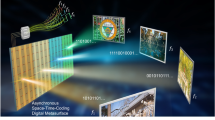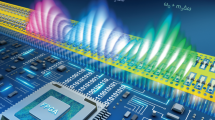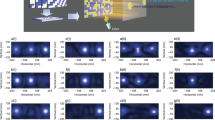Abstract
Digitally programmable metasurfaces are of potential use in wireless multiplexing techniques because they can encode and transmit information without using traditional radio-frequency components such as antennas or mixers. Space–time-coding digital metasurfaces can, in particular, manipulate the propagation direction and harmonic power distribution of electromagnetic waves, making them suitable for space- and frequency-division multiplexing. However, while digital metasurfaces have been used for wireless communication, these systems could implement signal modulation only in the time domain. Here, we report a wireless communication scheme that uses space–time-coding digital metasurfaces to implement both space- and frequency-division multiplexing. By encoding space–time-coding matrices through multiple channels, digital messages can be directly transmitted to different users at different locations simultaneously, without the need for digital-to-analogue conversion and mixing processes. To illustrate this approach, we have built a dual-channel wireless communication system based on a two-bit space–time-coding digital metasurface and use it to transmit two different pictures to two users simultaneously in real time.
This is a preview of subscription content, access via your institution
Access options
Access Nature and 54 other Nature Portfolio journals
Get Nature+, our best-value online-access subscription
$29.99 / 30 days
cancel any time
Subscribe to this journal
Receive 12 digital issues and online access to articles
$119.00 per year
only $9.92 per issue
Buy this article
- Purchase on Springer Link
- Instant access to full article PDF
Prices may be subject to local taxes which are calculated during checkout






Similar content being viewed by others
Data availability
The data that support the plots within this paper and other findings of this study are available from the corresponding authors upon reasonable request.
References
Pendry, J. B. Negative refraction makes a perfect lens. Phys. Rev. Lett. 85, 3966–3969 (2000).
Pendry, J. B., Schurig, D. & Smith, D. R. Controlling electromagnetic fields. Science 312, 1780–1782 (2006).
Zheludev, N. I. & Kivshar, Y. S. From metamaterials to metadevices. Nat. Mater. 11, 917–924 (2012).
Yu, N. F. et al. Light propagation with phase discontinuities: generalized laws of reflection and refraction. Science 334, 333–337 (2011).
Glybovski, S. B., Tretyakov, S. A., Belov, P. A., Kivshar, Y. S. & Simovski, C. R. Metasurfaces: from microwaves to visible. Phys. Rep. 634, 1–72 (2016).
Sun, S. et al. High-efficiency broadband anomalous reflection by gradient meta-surfaces. Nano Lett. 12, 6223–6229 (2012).
Cui, T. J., Qi, M. Q., Wan, X., Zhao, J. & Cheng, Q. Coding metamaterials, digital metamaterials and programmable metamaterials. Light Sci. Appl. 3, e218 (2014).
Gao, L. H. et al. Broadband diffusion of terahertz waves by multi-bit coding metasurfaces. Light Sci. Appl. 4, e324 (2015).
Liu, S. et al. Anisotropic coding metamaterials and their powerful manipulation of differently polarized terahertz waves. Light Sci. Appl. 5, e16076 (2016).
Zhang, L. et al. Realization of low scattering for a high-gain Fabry–Perot antenna using coding metasurface. IEEE Trans. Antennas Propag. 65, 3374–3383 (2017).
Moccia, M. et al. Coding metasurfaces for diffuse scattering: scaling laws, bounds and suboptimal design. Adv. Opt. Mater. 5, 1700455 (2017).
Zhang, L., Liu, S., Li, L. & Cui, T. J. Spin-controlled multiple pencil beams and vortex beams with different polarizations generated by Pancharatnam–Berry coding metasurfaces. ACS Appl. Mater. Interfaces 9, 36447–36455 (2017).
Liu, S. et al. Anomalous refraction and nondiffractive Bessel-beam generation of terahertz waves through transmission-type coding metasurfaces. ACS Photonics 3, 1968–1977 (2016).
Zhang, L. et al. Transmission-reflection-integrated multifunctional coding metasurface for full-space controls of electromagnetic waves. Adv. Funct. Mater. 28, 1802205 (2018).
Xie, B. et al. Coding acoustic metasurfaces. Adv. Mater. 29, 1603507 (2017).
Ma, M. et al. Optical information multiplexing with nonlinear coding metasurfaces. Laser Photon. Rev. 13, 1900045 (2019).
Wan, X., Qi, M. Q., Chen, T. Y. & Cui, T. J. Field-programmable beam reconfiguring based on digitally-controlled coding metasurface. Sci. Rep. 6, 20663 (2016).
Yang, H. et al. A programmable metasurface with dynamic polarization, scattering and focusing control. Sci. Rep. 6, 35692 (2016).
Huang, C. et al. Dynamical beam manipulation based on 2-bit digitally-controlled coding metasurface. Sci. Rep. 7, 42302 (2017).
Dai, J. Y., Zhao, J., Cheng, Q. & Cui, T. J. Independent control of harmonic amplitudes and phases via a time-domain digital coding metasurface. Light Sci. Appl. 7, 90 (2018).
Li, L. et al. Electromagnetic reprogrammable coding-metasurface holograms. Nat. Commun. 8, 197 (2017).
Li, L. et al. Machine-learning reprogrammable metasurface imager. Nat. Commun. 10, 1082 (2019).
Li, L. et al. Intelligent metasurface imager and recognizer. Light Sci. Appl. 8, 97 (2019).
Xia, J. P. et al. Programmable coding acoustic topological insulator. Adv. Mater. 30, 1805002 (2018).
Zeng, H. et al. Broadband terahertz reconfigurable metasurface based on 1-bit asymmetric coding metamaterial. Opt. Commun. 458, 124770 (2020).
Cui, T. J., Liu, S. & Li, L. L. Information entropy of coding metasurface. Light Sci. Appl. 5, e16172 (2016).
Liu, S. et al. Convolution operations on coding metasurface to reach flexible and continuous controls of terahertz beams. Adv. Sci. 3, 1600156 (2016).
Cui, T. J., Liu, S. & Zhang, L. Information metamaterials and metasurfaces. J. Mater. Chem. C 5, 3644–3668 (2017).
Zhao, J. et al. Programmable time-domain digital-coding metasurface for non-linear harmonic manipulation and new wireless communication systems. Natl Sci. Rev. 6, 231–238 (2019).
Dai, J. Y. et al. Wireless communications through a simplified architecture based on time‐domain digital coding metasurface. Adv. Mater. Technol. 4, 1900044 (2019).
Dai, J. Y. et al. Realization of multi-modulation schemes for wireless communication by time-domain digital coding metasurface. IEEE Trans. Antennas Propag. 68, 1618–1627 (2020).
Tang, W. et al. Programmable metasurface-based RF chain-free 8PSK wireless transmitter. Electron. Lett. 55, 417–420 (2019).
Tang, W. et al. Wireless communications with programmable metasurface: new paradigms, opportunities and challenges on transceiver design. IEEE Wirel. Commun. 27, 180–187 (2020).
Cui, T. J., Liu, S., Bai, G. D. & Ma, Q. Direct transmission of digital message via programmable coding metasurface. Research 2019, 1–12 (2019).
Wan, X. et al. Multichannel direct transmissions of near-field information. Light Sci. Appl. 8, 60 (2019).
Basar, E. et al. Wireless communications through reconfigurable intelligent surfaces. IEEE Access 7, 116753–116773 (2019).
Di Renzo, M. et al. Smart radio environments empowered by reconfigurable intelligent surfaces: how it works, state of research and road ahead. IEEE J. Sel. Areas Commun. 38, 2450–2525 (2020).
Huang, C. et al. Reconfigurable intelligent surfaces for energy efficiency in wireless communication. IEEE Trans. Wirel. Commun. 18, 4157–4170 (2019).
Wu, Q. & Zhang, R. Intelligent reflecting surface enhanced wireless network via joint active and passive beamforming. IEEE Trans. Wirel. Commun. 18, 5394–5409 (2019).
Wu, Q. & Zhang, R. Towards smart and reconfigurable environment: intelligent reflecting surface aided wireless network. IEEE Commun. Mag. 58, 106–112 (2020).
Han, Y. et al. Large intelligent surface-assisted wireless communication exploiting statistical CSI. IEEE Trans. Veh. Technol. 68, 8238–8242 (2019).
Tang, W. et al. Wireless communications with reconfigurable intelligent surface: path loss modeling and experimental measurement. IEEE Trans. Wireless Commun. 20, 421–439 (2021).
Shaltout, A. M., Shalaev, V. M. & Brongersma, M. L. Spatiotemporal light control with active metasurfaces. Science 364, eaat3100 (2019).
Hadad, Y., Sounas, D. L. & Alù, A. Space–time gradient metasurfaces. Phys. Rev. B 92, 100304(R) (2015).
Shaltout, A., Kildishev, A. & Shalaev, V. Time-varying metasurfaces and Lorentz non-reciprocity. Opt. Mater. Express 5, 2459–2467 (2015).
Correas-Serrano, D. et al. Nonreciprocal graphene devices and antennas based on spatiotemporal modulation. IEEE Antennas Wirel. Propag. Lett. 15, 1529–1532 (2016).
Salary, M. M., Jafsecurear-Zanjani, S. & Mosallaei, H. Electrically tunable harmonics in time-modulated metasurfaces for wavefront engineering. New J. Phys. 20, 123023 (2018).
Ramaccia, D., Sounas, D. L., Alù, A., Toscano, A. & Bilotti, F. Doppler cloak restores invisibility to objects in relativistic motion. Phys. Rev. B 95, 075113 (2017).
Wu, Z. & Grbic, A. Serrodyne frequency translation using time-modulated metasurfaces. IEEE Trans. Antennas Propag. 68, 1599–1606 (2020).
Ramaccia, D., Sounas, D. L., Alù, A., Toscano, A. & Bilotti, F. Phase-induced frequency conversion and Doppler effect with time-modulated metasurfaces. IEEE Trans. Antennas Propag. 68, 1607–1617 (2020).
Zhang, L. et al. Space–time-coding digital metasurfaces. Nat. Commun. 9, 4334 (2018).
Zhang, L. et al. Breaking reciprocity with space–time-coding digital metasurfaces. Adv. Mater. 31, 1904069 (2019).
Zhang, L. et al. Dynamically realizing arbitrary multi-bit programmable phases using a 2-bit time-domain coding metasurface. IEEE Trans. Antennas Propag. 68, 2981–2992 (2020).
Goldsmith, A. Wireless Communications (Cambridge Univ. Press, 2005).
Daly, M. P. & Bernhard, J. T. Directional modulation technique for phased arrays. IEEE Trans. Antennas Propag. 57, 2633–2640 (2009).
Acknowledgements
This work was supported by the National Key Research and Development Program of China (2017YFA0700201, 2017YFA0700202 and 2017YFA0700203), the National Natural Science Foundation of China (61631007, 61571117, 61501112, 61501117, 61522106, 61731010, 61735010, 61722106, 61701107 and 61701108), the National Science Foundation of China for Distinguished Young Scholars (61625106) and the 111 Project (111-2-05).
Author information
Authors and Affiliations
Contributions
T.J.C. suggested the designs and planned and supervised the work, in consultation with Q.C. and S.J. L.Z. conceived the idea and carried out the theoretical analysis and numerical simulations. L.Z., M.Z.C., W.T. and J.Y.D. built the system and performed the experimental measurements. L.Z., L.M. and X.Y.Z. performed the data analysis. L.Z. and T.J.C. wrote the manuscript. All authors discussed the theoretical aspects and numerical simulations, interpreted the results and reviewed the manuscript.
Corresponding authors
Ethics declarations
Competing interests
The authors declare no competing interests.
Additional information
Peer review information Nature Electronics thanks Ertugrul Basar, Shuai Nie and Din Ping Tsai for their contribution to the peer review of this work.
Publisher’s note Springer Nature remains neutral with regard to jurisdictional claims in published maps and institutional affiliations.
Supplementary information
Supplementary Information
Supplementary Figs. 1–5 and Notes 1–6.
Supplementary Video 1
The process of transmitting two different colour pictures through the dual-channel wireless communication system.
Rights and permissions
About this article
Cite this article
Zhang, L., Chen, M.Z., Tang, W. et al. A wireless communication scheme based on space- and frequency-division multiplexing using digital metasurfaces. Nat Electron 4, 218–227 (2021). https://doi.org/10.1038/s41928-021-00554-4
Received:
Accepted:
Published:
Issue Date:
DOI: https://doi.org/10.1038/s41928-021-00554-4
This article is cited by
-
Linear and phase controllable terahertz frequency conversion via ultrafast breaking the bond of a meta-molecule
Nature Communications (2024)
-
Vision-driven metasurfaces for perception enhancement
Nature Communications (2024)
-
Frequency-hopping wave engineering with metasurfaces
Nature Communications (2024)
-
Multi-stream signals separation based on space-time-isomeric (SPATIO) array using metasurface antennas
Science China Information Sciences (2024)
-
Manipulations of multi-frequency waves and signals via multi-partition asynchronous space-time-coding digital metasurface
Nature Communications (2023)



